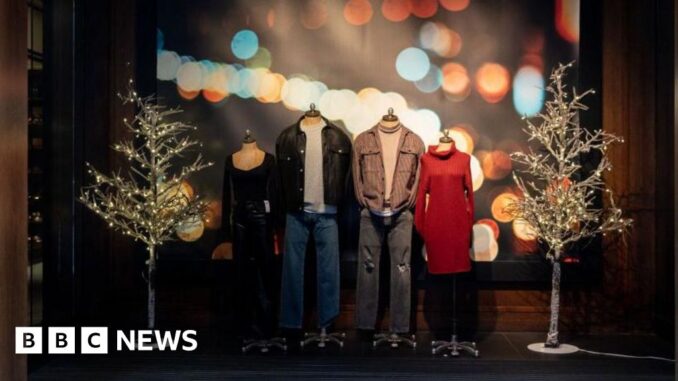
It is not just styles from the 1990s that are making a comeback. One of the decade’s biggest brands is too.
Abercrombie & Fitch appears on track for a second year of double digit sales growth – its first such streak in more than a decade.
The company, which also owns Hollister, has told investors it expects sales this year to rise 10% from 2023.
That is nearly double its prior forecast, and comes after a 16% surge last year.
Known in the 90s for appealing to teens, and infamous for its shirtless models, the company is now going after grown-ups with wedding-wear, work appropriate offerings and wide leg, baggy jeans.
It has also taken a more inclusive approach, introducing a wider range of sizes, among other steps – a not insignificant shift for a company whose former chief executive, Mike Jeffries, once famously declared “a lot of people don’t belong” in the firm’s clothing.
Abercrombie in 2004 agreed to pay $50m (£39m) to settle claims that its hiring practices had discriminated against minorities and women.
Mr Jefferies also faced claims he had sexually exploited and abused men at events he hosted around the world and that he ran a sex trafficking ring, which he has denied.
Abercrombie, which Mr Jeffries left as boss in 2014, has since succeeded in reinventing itself, and appears to carry very little baggage from that time, said Neil Saunders, managing director at GlobalData.
The turnaround sent shares in the firm, which has more than 750 stores globally, surging from around $25 (£19) a piece at the start of 2023 to more than $189 (£147) on Thursday.
“I don’t think I’ve ever seen a brand come back from the dead this fast,” Jonah Lupton, chief executive at Lupton Capital wrote on social media, remarking on the rise.
While the spaghetti straps, bucket hats and platform shoes popular in the 90s are enjoying a fashion revival, Abercrombie’s offerings are not a repeat of the decade.
Rather, Mr Saunders said the company’s range, less sexy and with fewer logos than in the 90s, is resonating with millennial customers who want to look fresh without following the latest “cutting edge” fashions.
He said the success of Abercrombie’s turnaround is unusual in retail.
“It’s quite rare for a company of Abercrombie & Fitch’s direction and its rooted image from the 90s to do a complete 180 and emerge as a very modern and successful and different brand,” he said. “We don’t see it happen very often.”
The firm said sales jumped 22% year-on-year in the February-April period to $1bn (£787m), a quarterly record.
The growth was widespread, with revenue up 23% in the Americas and 19% in Europe, where the UK and Germany led gains.
Current Abercrombie boss Fran Horowitz, who became chief executive in 2017, said 2023 had been a defining one for the company, as its efforts to modernise its data and digital capabilities paid off.
“We entered 2024 with momentum,” she told analysts on a call to discuss the quarterly financial results.
“Our first quarter results are further evidence that we are off to a strong start.”
Shares jumped more than 20% after the report, despite a note of caution from chief financial officer Scott Lipesky, who warned there was “still a lot of uncertainty” about the economy.
He said that the firm’s sales could slow in the second half of the year.
Mr Saunders said some slower growth was expected after the boom of 2023, but that the firm was still outpacing the overall market and had an opportunity to grow overseas in countries such as the UK.
Ms Horowitz focused on that prospect during the quarterly update, noting a recent visit to London.
“We’re really excited about the opportunity that we see there,” she said.


Be the first to comment